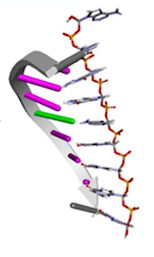
Published 2024-03-04
Keywords
- antisense oligonucleotide,
- cancer,
- carcinogenesis suppression,
- prevention,
- therapy
How to Cite
Copyright (c) 2024 Jack S. Cohen, Barak Akabayov

This work is licensed under a Creative Commons Attribution 4.0 International License.
Abstract
Antisense oligonucleotide (ASO) analogs have been used to counteract the effects of mutated genes and have been developed as therapeutic agents. Several such formulations have been subjected to clinical trials against cancer and have been passed by the FDA for clinical use. However, cancer is a complex genetic disease in which multiple mutations are known to occur for tumors to develop. Three basic stages have been delineated: 1. Loss of cell growth control by both oncogenes and tumor suppressor genes; 2. Angiogenesis, the production of capillary growth factors to allow blood supply; 3. Metastasis allows cancer cells to invade normal tissue. In principle, using three ASOs to down-regulate the products of the mutated genes controlling these specific processes should be possible and this could be an effective preventive method against cancer. In an alternative approach, genetic analysis of cancer cells using microarrays have shown that cassettes of genes are up- and down-regulated compared to normal tissue. Using this information ASOs could be used to down-regulate mutated genes that are up-regulated. In general ASO analog sequences could be used to target the unique pre-mRNA splice sites of selected genes in order to suppress carcinogenesis in vitro in selected cancer cell lines and subsequently in vivo in chosen mouse models. Computer programs will be used to calculate doses of a cocktail of ASOs to be administered to individual mice and ultimately patients as their tumor genetic profile changes over time.
References
- J.S. Cohen, History of Research on Antisense Oligonucleotide Analogs, Substantia (Intl. J. Hist. Chem.) 5 9-25, 2021 (review with 166 refs.).
- A.P. Albino; E.D. Jorgensen, Multistage Carcinogenesis, in Encyclopedia of Cancer, 2nd ed., ed. by J. R. Bertino, Academic Press, New York, Vol. 3, pp. 275-85. 2002,
- R. Galindo-Murillo; J.S Cohen; B. Akabayov, Comparative Study Using Molecular Dynamics Calculations of Antisense Oligonucleotide Analogs Ability to Duplex with RNA, unpublished results, 2022.
- J. C. Reed; C. A. Stein; C. A. Subasinghe; S. Haldar; C. M. Croce; S. Yum J. S. Cohen, Antisense-mediated inhibition of BCL2 proto-oncogene expression and leukemic cell growth; comparisons of phosphorothioate oligonucleotides, Cancer Res. 50 6565-70, 1990.
- S. L. Loke; X. H. Zhang; C. A. Stein; M. Avigan; J. S. Cohen; L. M. Neckers, Delivery of c-myc antisense phosphorothioate oligodeoxynucleotides to hematapoietic cells in culture by liposome fusion, Curr. Top. Microbiol. Immunol. 141 282-9, 1988.
- R. Galindo-Murillo, J.S. Cohen, B. Akabayov, Molecular Dynamics Simulations of Acyclic Analogs of Nucleic Acids for Antisense Inhibition, Molec. Therap. - Nucl. Acids, 23 527-35, 2020.
- Biopharma, Oligonucleotide Drugs: Current Status and Challenges, https://www.biochempeg.com/article/124.html, 2020.





